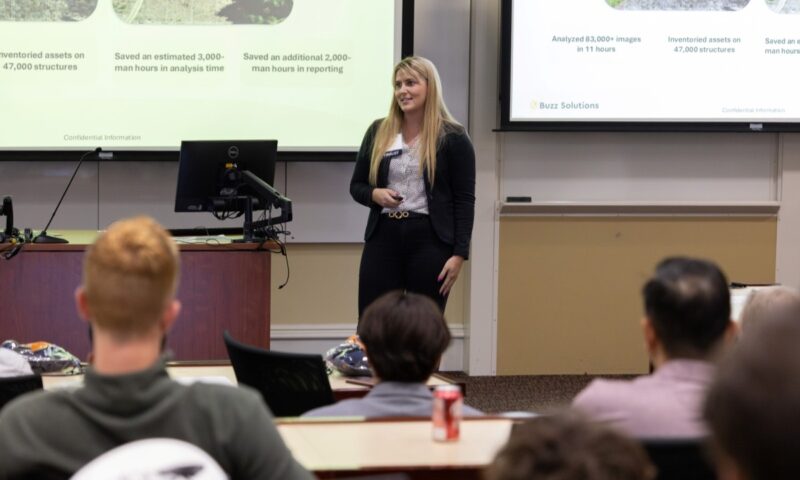
Jenna Lloyd
Jenna Lloyd says that she has always felt called to serve others.
Lloyd first followed her calling by enrolling in an influential Certified Nursing Assistant class, where she had her initial experiences working with patients, nurses, and members of an interdisciplinary healthcare team.
She remembers how much she enjoyed helping patients, doing what she could to brighten their day or to make their situation more bearable. “It is an opportunity to serve people during some of their most vulnerable times, providing the highest quality of care, and ensuring dignity for the patients we serve,” she says.
That early commitment led her to pursue a B.S. in Nursing at the University of Lynchburg. While she enjoyed her time as a registered nurse, she says that the good fortune of working with some amazing nurse practitioners sparked her interest in following that career path.
Lloyd says that her choice afforded her the opportunity to connect with patients in the post-acute care setting, where she was able to develop a plan of care with the goal of improving their quality of life. “It was a very rewarding experience,” she recalls, and ultimately, it was an experience that sparked her interest in healthcare informatics.
She earned her M.S.N. (Family Nurse Practitioner) from UVA in 2002, and returned to Grounds to earn her D.N.P. in Nursing in 2012 and her M.S. in the Management of Information Technology from McIntire in 2013. Working as a Certified Nurse Practitioner for more than 11 years with Centra Health and then in the dual roles of NP and Clinical Liaison in ambulatory informatics for three years, Lloyd served as Director of the Nursing Program and as an Assistant Professor at the University of Lynchburg from 2014 through 2018. She was also interim Director of the Health Information Management program.
In June 2018, Lloyd returned to IT—and her former employer Centra. The organization created a new position that gave her the opportunity to apply her strategic knowledge to support her deep experience in the nursing field: Chief Nursing Information Officer (CNIO). We recently spoke with her about her new job and how the experiences of McIntire’s M.S. in MIT Program prepared her for the many pressing challenges of the industry.
Update: As of June 2019, Jenna Lloyd is serving in the role of Interim Chief Information Officer for Centra as the company conducts a national search for its CIO position.
How did the M.S. in MIT help you break new ground in your role as Centra’s first CNIO?
McIntire’s M.S in MIT allowed me to learn a different skill set and to look through a strategic lens when working through organizational issues and solutions. I love processes! When they are executed right, great things can happen and have a major positive impact on the organization.
I wanted the ability to look at things differently and understand how to address and dissect concerns at a higher level. The McIntire experience provided opportunities to develop leadership skills and make decisions with a strategic mindset. It also afforded me an enriching, impactful, and well-rounded experience by giving me the opportunity to work with and learn from people from diverse backgrounds and industries.
The program taught me how to use resources to examine technology quickly and thoroughly and to make strategic decisions based on current data and research—while applying those concepts in real time. These tools and skills are transferable across roles to support career transitions and further career growth.
It also taught me the value of brevity. For example, knowing how to state the bottom line up front (BLUF) when bringing proposals forward, understanding how to determine the ROI of a potential investment, and evaluating that ROI once implemented have been invaluable.
How did your personal perspective of healthcare and IT inform your class discussions and your approach to the coursework?
When I joined the Class of 2013, I had been in healthcare for 16 years and had been exposed to every level of nursing, from the role of CNA, then RN, and NP, working as a Clinical Liaison for ambulatory informatics, and then earning my D.N.P., with research focused on healthcare informatics. My background was diverse—I understood healthcare from the CNA role all the way through to the provider role, including day-to-day practice regulations and accreditation requirements surrounding those areas.
I was fortunate to work for a practice that was an early adopter of the EHR. At that time, 2002, the office had some support for the EHR, but needed more to ensure efficient, quality, and safe patient care. I began to learn how to make changes to that system by building protocols that addressed workflow challenges and improved efficiency.
I started to split my time between acting as an NP and a Clinical Liaison. We had been acquired by the healthcare system and were no longer a private physician practice. Shortly after the acquisition, I began working with a team that was deploying the EHR to more than 30 provider practices. This role helped further my understanding of the need for deployment processes and a system that support evidence-based practice for our providers. As part of my doctorate program, I completed a project on embedding clinical decision support into the EHR to improve guideline adherence.
My previous experience allowed me to work through use cases and add to the discussion of the impact of the technology for both the organization and the consumer. My approach is on the experience from the front end to the back end, because the user experience is what can propel you to meet your mission. Interestingly, many of the projects we worked on in McIntire’s program were healthcare-related.
What are your day-to-day job responsibilities? What are your days like?
Currently, there is a lot going on. From a strategic standpoint, I serve on several committees and as the voice of the nurse for IT needs.
I make rounds on the units quite a bit, as I like to talk with the nurses in their environment daily to understand what is working well and what needs to be evaluated for change. Interacting with the nurses and all members of the organization fills my cup! I love serving and being a part of this healthcare system.
What is it about tackling these issues that’s most appealing to you?
I am drawn to this position because I love to serve. If we have enough people collectively working together, we can achieve and support excellent healthcare. We need to leverage the technology in this space to deliver world-class care to our patients, while decreasing costs and expenditures and improving both the value of care and the staff experience.
I am excited about helping our clinicians develop better ways to deliver care and decrease their documentation burden in hopes of offsetting burnout and continuing to inspire people to work in nursing and medicine. Being able to strategically develop a plan to address these challenges is also exciting for me because I know together we can transform healthcare delivery for our patients and ensure our patients receive excellent care for life.
Great Challenges Facing Healthcare Informatics
Four complex issues provide opportunities to usher in meaningful changes, Lloyd says. As she leverages technology at Centra Health to add business value—while at the same time positively impact patient care—she explains how several problems affect the entire industry:
1. Healthcare systems face continued challenges with interoperability and data analytics. Systems need to be able to exchange data—no matter where you receive your care. Regulations are helping to drive this need, but it has yet to be mastered. The 1999 report by the former Institute of Medicine stated that 40,000 to 98,000 medical errors led to death annually; other reports have estimated this number to be anywhere between 200,000 to 400,000 patients deaths per year. The bottom line is that we’ve got to do better. If we exchange data and turn that data into information that leads to knowledge and informs decisions, we can decrease medical errors.
2. The user experience for the patient, clinician, and nonclinical has opportunities for improvement. Nursing and medicine are both experiencing clinician shortages. At a time of workforce scarcity, we must focus on decreasing burnout. Technology should be able to help with that. As we continue to try to determine and defend the value of EHR, we face the reality that the large-scale deployments may contribute to decreased provider engagement and increased burnout.
We have an opportunity in the next five years to make these now clunky (at best) systems more streamlined and efficient to impact the clinician and non-clinician staff experience, and to make it much better than what it is today.
3. Healthcare costs are rising. The growing trend of accountable care organizations (ACOs) and increased regulatory pressure is another challenge.
In a time when payment structures are changing, regulations are increasing, and healthcare systems are being measured differently than they have ever been before, we are challenged by the infrastructure to ensure that EHR can easily capture the required elements and aid in making the best clinical decisions for patients.
Healthcare expenditure represents roughly 18% of U.S. GDP. We have got to work to better leverage technology to add value to our healthcare community by decreasing cost and increasing quality.
4. Users in the workforce must be trained. Educating users on the proper methods for using the technology can be problematic. When you transition from one EHR to another, it is difficult to retrain. Things that may be better in the new system may not readily appear that way to end users because they are still learning how to navigate it.
Because the workflows are so important for ensuring compliance with policies and regulations, and because they impact patient care and outcomes, it is critically important to educate users about the workflows—no matter how seemingly minute the change. End user education will remain a challenge that organizations must address to ensure effective standardization and quality delivery.


